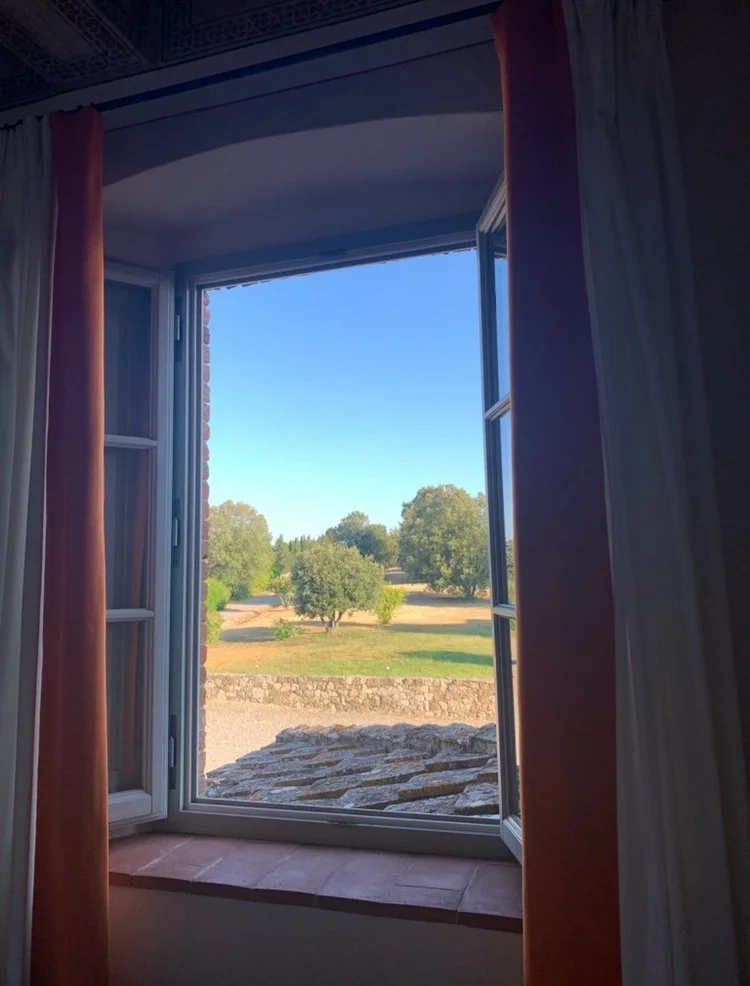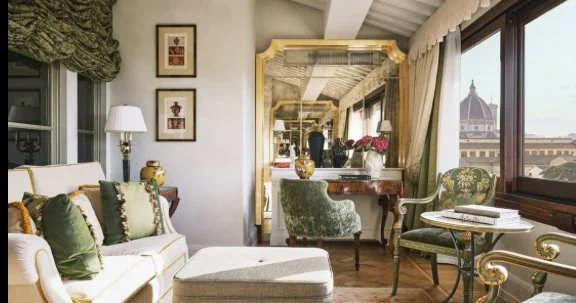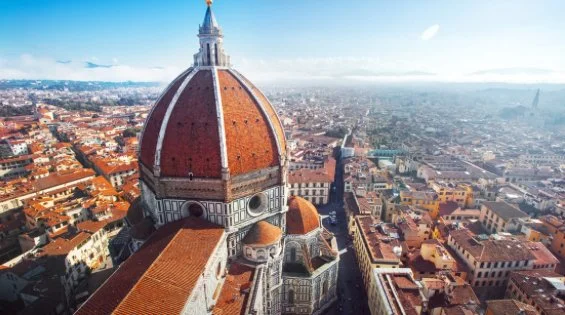Room With A View / TUSCANY
I start my tour of Tuscany in the vaulted wine cellar of a 12th-century castle, comparing notes on a bottle of Chianti with the Scottish First Minister.
Castello del Nero, all heavy stone and vaulted arches, sits inside a 700-acre estate of olive groves and vineyards. There’s a shuttle to Florence for official matters, but tonight, like everyone else, we’re here to forget the British winter and surrender to the deep rhythms of Tuscan tradition — wine first, food, more wine.
“We don’t quite have the climate back home,” he says, as we move on to bottle number three. We’re learning to read the DOCG label — a strict badge of origin and quality. The real Chianti Classico always carries a Black Rooster on the neck of the bottle. The story, like most things in Italy, is a mixture of strategy, art, and war.




Centuries ago, Siena and Florence agreed to settle a land dispute not with bloodshed but a race. Each city would send a rider at dawn. Florence chose a black rooster, starved it into crowing early, and won the race by sheer cunning. The border held. The rooster stuck.
Il Gallo Nero
Sangiovese — the “blood of Jupiter” grape — is the foundation of the region. We drink it with local cold cuts and pappa al pomodoro, a thick tomato and bread soup that tastes better than it sounds. Supper is slow-cooked Cinta Senese pork and zuccotto — a domed, brandied pudding said to echo the curves of Florence’s cathedral. Everything is warm, rich, and made to be remembered.
You can leave London on a Friday afternoon, land in Pisa, and be in Chianti by sundown. Out of season, Tuscany sharpens. The air is clearer. The light falls longer. The gardens at Castello del Nero are quiet — roses and cypress against stone. In the morning, with only a few guests by the pool, it feels like a private house party.
The Shape of a City
When I ask for Florence tips, I expect the Uffizi or Michelangelo. Instead, the First Minister suggests Ferragamo’s shoe museum.
“There’s a good Mae West exhibition,” he says. “And my wife loves shoes.”
The Ferragamo story is pure fable: a southern Italian cobbler moves to California, opens the Hollywood Boot Shop, and becomes the footman to the stars. West, Gardner, Hepburn — all his. Wartime scarcity forced invention: cork wedges, cellophane straps, shoes made from straw and sweet wrappers. Today, 13,000 pairs sit in his Florentine museum — a shrine to craft, ingenuity, and good ankles.
The Secret Garden
If you’re staying the night in Florence, stay in style. The Four Seasons is tucked inside an 11-acre Renaissance garden, part palace, part convent, with an emerald green pool that somehow still feels secret. Children splash in the shallows while Hollywood A-listers pass through reception. Former residents include a pope, a viceroy of Egypt, and an order of nuns. If you’re not sleeping here, book dinner at Il Palagio and ask to see the chapel turned library — frescoes intact.
From Florence, we drive into the hills to Villa San Michele. Once a Franciscan monastery, its façade is attributed to Michelangelo, and the piano bar has played host to Bardot and Annan alike. Our garden villa looks over the whole of Florence — a view so cinematic it needs no filter. At dinner, I’m handed a menu without prices. Feeling like Sophia Loren, I order with abandon while my other half — for the first time in a decade — skips dessert. It’s that kind of place.
The Art of the Bluff
We’ve been winding through Tuscany all week in a dusty Fiat Panda, squeezed between Ferraris on more than one driveway. At Villa San Michele, we unload in double time, hoping someone mistakes us for the Lamborghini. The concierge, looking like Cary Grant and speaking perfect English, catches our bluff.
“Ah, Fiat,” he smiles. “Same family as Ferrari.”
We trade up to a Jaguar E-type Roadster for the next leg — south to Borgo Santo Pietro, a 13th-century villa turned sanctuary with a natural pool, rose gardens, tennis court, and a small spa. Once a stopover for pilgrims, now a study in sustainable elegance.
Stone Towers, Silk Skies
On the way back north, we take refuge from a storm in San Gimignano. The towers rise like punctuation marks from another century. We hear Sunday mass from the Romanesque Duomo and spend the night at Leon Bianco, a faded palazzo with views over the medieval skyline. Tuscany feels layered, built from stories. Some real. Some invented. All convincing.
Our last stop is Villa Bodoni — a noble house outside Greve that hums with nostalgia. Once left to dust and ivy, it’s now a warm, candlelit villa with roaring fires and serious food.
We end where we began — under stars, with wine, and the kind of feast that makes it hard to leave.
Viewfinder: Tuscany
Roomkey
Castello del Nero, Tavarnelle
12th-century fortress turned low-key luxury base. Olive groves, frescoed suites, and a wine cellar that doubles as a classroom. Shuttle to Florence if you must. Ideal for escaping your own inbox.Four Seasons, Florence
A former convent, palace, and papal hangout, now with kids in the pool and A-listers at check-in. Lush gardens, killer Duomo views, and rooms good enough for a viceroy’s harem (which, fun fact, was once banned). Stay if you’re flush — or eat at Il Palagio and pretend.Borgo Santo Pietro, near Chiusdino
A 13th-century pilgrim stop turned ultra-refined eco-sanctuary. Solar-powered, Michelin-starred, and more roses than Versailles. Natural pool, private farm, and enough silence to hear yourself think.Villa San Michele, Fiesole
Ex-monastery. Possible Michelangelo façade. Views over Florence you’ll carry for life. Piano bar has hosted Bardot and Kofi Annan. Order the tiramisu and try not to check the price.Villa Bordoni, Greve in Chianti
Less polished, more soulful. Fires crackle, books pile high, wine flows. Feels like staying with that eccentric aristocrat you always wished you had in the family. Bring someone who reads.
Table With A View
Castello del Nero
Dinner under the stars. Handmade pasta, Cinta Senese pork, that Zuccotto dome. Come early — start in the candlelit wine vault, Chianti in hand, stories flowing.Il Palagio, Four Seasons Florence
Florentine grandeur done right. White tablecloths, chandeliers, and dishes that hum with restraint and confidence. Dine beside frescoes, then walk it off in the ‘secret garden’.Borgo Santo Pietro
Farm-to-fork, literally. Ingredients grown metres away. Try the herb-fed lamb or whatever the chef pulled from the earth that morning. Tables framed by rose gardens and cypress.Villa San Michele
You’re here for the view — a sweep of Florence that feels like a Caravaggio. Food is refined, romantic, and served with quiet theatre. Skip lunch, splurge at dusk.Villa Bordoni
Candlelit tables scattered among palm trees and vines. Home-style Tuscan dishes done beautifully. Wine flows. Service low-key, discreet. The kind of place where you’ll linger too long, and still wish the night didn’t end.
On The Road
Best drive in Tuscany? Florence to Siena via the SR222 — the old Chiantigiana road. Curves like a film reel, villages like sets, cypress trees like punctuation.
Start in a Fiat Panda, end in a Jaguar E‑Type. Or vice versa. It’s the contrast that makes it cinematic.
Castello del Nero to Borgo Santo Pietro: morning light, empty roads, espresso stop somewhere no one speaks English.
Pull over for San Gimignano, dodge the tour buses, and climb the Torre Grossa if your legs allow.
Final retreat: Villa Bordoni, Greve in Chianti. Dusty car. Cold wine. Fire lit. Done.
Windowseat
Fly direct to Pisa or Florence from major UK and EU cities. Florence lands you closest to the culture; Pisa gets you to the hills quicker.
Hire a car — manual, small, and ideally red.
Best arrival: Late Friday, Chianti by sunset. Bags in the boot, road playlist on, cypress trees silhouetted.
Skip: Tour buses, group tours, overplanning. Tuscany’s best seen through the windscreen, with the windows down.
Future Frame: For the Global Citizen
Solar panels power the suites at Borgo Santo Pietro.
Villa Bordoni grows its own.
Castello del Nero presses olive oil on site.
Four Seasons restores heritage, not just buildings.
Choose slow stays, hybrid drives, and properties with a conscience. Tuscany’s future is rooted in the land.
Originally published in the Hampstead & Highgate Express (Ham & High), and syndicated across London titles.

